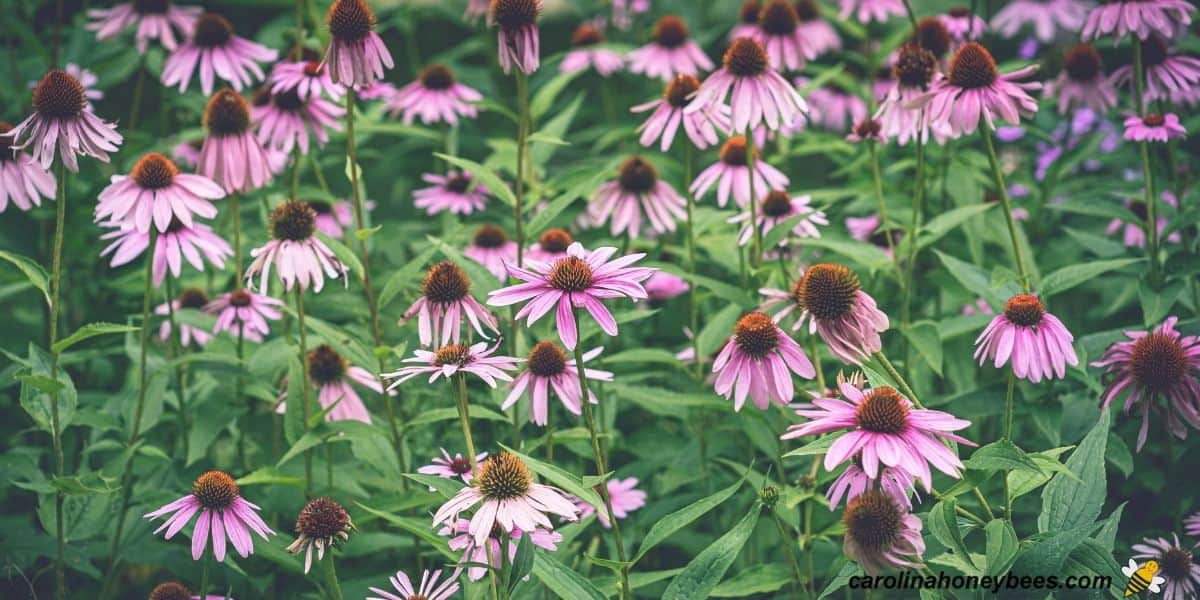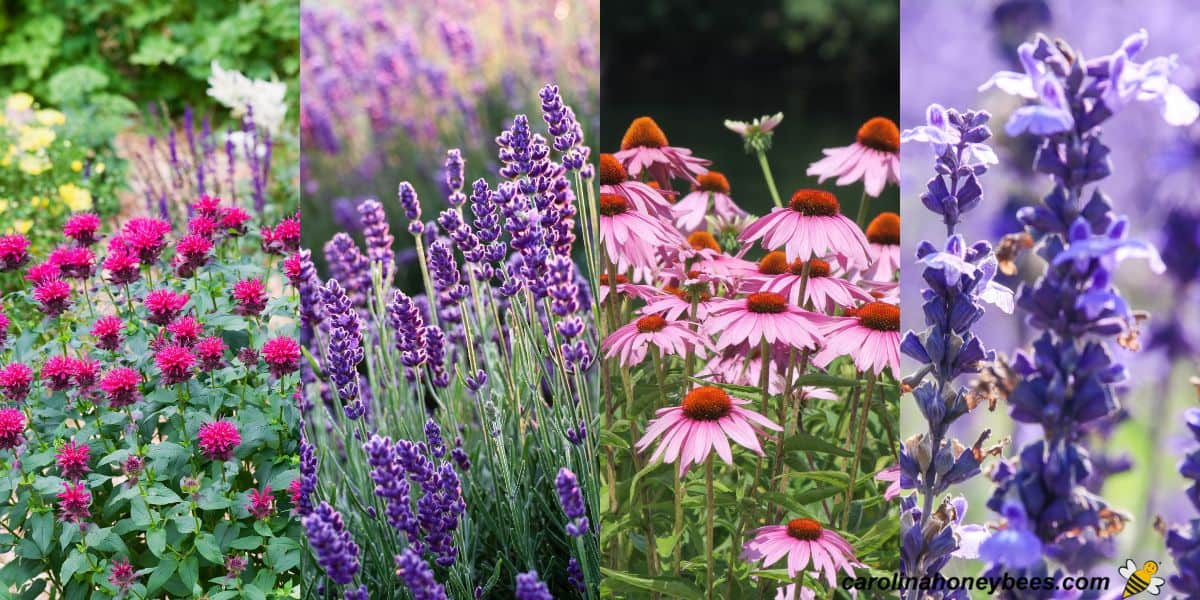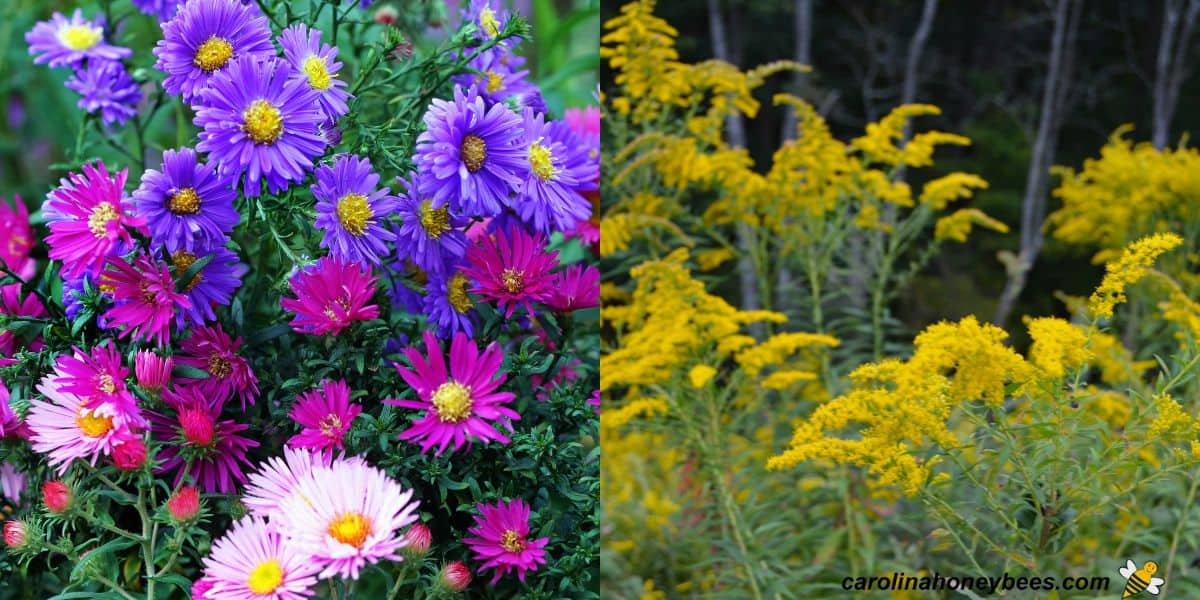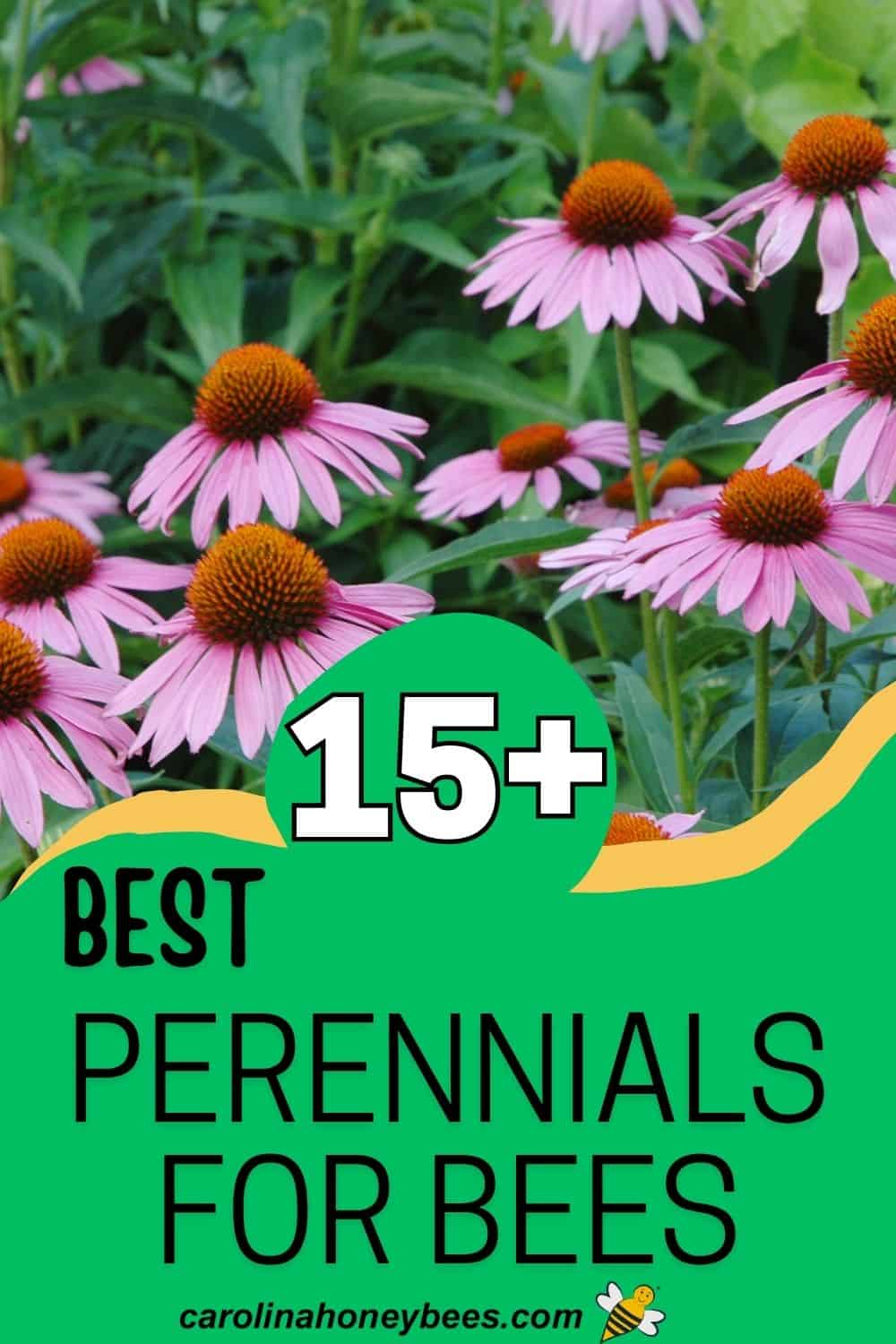Best Perennials for Bees
Creating a pollinator garden is one of the most rewarding things you can do to help all pollinators – including bees. While not all flowers feed bees, choosing the right perennials can provide reliable sources of nectar and pollen year after year. In this guide, you’ll learn which bee-friendly perennials will keep your garden buzzing from early spring through fall.

An experience beekeeper, I have some flowers just for me – they may not feed bees. Yet, when planting I always consider it a plus if some of my choices include flowers for bees, butterflies or hummingbirds.
Why Perennials are Great for Bees & Other Pollinators
Bees (honey bees my favorite – of course) but other types of pollinators need both plant nectar and pollen. They do a great job of finding food in the wild.
However, anything we can do to provide a steady supply increases the colony’s chance of survival.
The very best bee habitats will have a mix of different kinds of plants. Annual flowers (that bloom die and don’t come back), perennials (multi-season plants), trees, shrubs that bees like – all provide valuable forage.
Key Positives for Bee Friendly Perennials:
- tend to have long bloom periods
- are sustainable (returning year after year)
- most are easy to grow and do not require special care
- offer a diverse mix of colors and bloom type (great for bee nutrition)

Top Perennials That Attract Bees
As you plan you garden, don’t forget to consider the wildflowers that feed bees in your region. Ideally, you need plants that will bloom a long time or fill in sparse times of natural bloom.
These perennials bees love are roughly broken down into season of bloom. However, keep in mind that climate and current weather conditions affect bloom time of any plant.
Late Winter and Early Spring Bloomers
In many regions, bee food sources are far and few between during the cold months. That’s okay – bumble bees are hibernating and honey bees are clustered warmly inside the hive.
But, even the coldest areas may have some warmish days that foraging bees venture out looking for any fresh food sources.
These first nectar plants help sustain colonies with low food stores. Just as important, they help ramp up production of bee brood – the next generation.
Though smaller in number Winter plants for bees make a significant contribution for any bees that come out during this time.

1. Crocuses (Crocus spp.)
Crocuses are low growing brightly colored flowers that are one of the first to bloom in late Winter. They grow from a small bulb that you plant in the Fall. With bright colors of purple, white and yellow – they provide bees with a rich source of early season pollen.
2. Dandelions (Taraxacum officinale)
Considered one of the many weeds that attract bees, dandelions can be found growing all during the year. But, it is their nectar and pollen provided early in the season that is most important.
While dandelions are not the perfect food source for bees, their contribution to Spring population build up should not be overlooked.
And after the early season is over, pick them and make yourself some herbal DIY dandelion salve – I do.
3. Hellebores (Helleborus spp.)
In my region, these plants are called Lenten roses. The heroes of the shade garden, Hellebores return year after year and are hardy to frost and freezes (to a degree).
Most importantly, their long lasting blooms provide nectar and pollen at a time when not much else is blooming.
4. Snowdrops (Galanthus spp.)
Snowdrops are delicate plants with drooping white flowers. These early blooming perennials attract bees by providing nectar.
Snowdrops make a nice addition to rock gardens and woodland areas. They are also planted as bulbs in Fall.
Spring and Early Summer Perennials
As the weather warms, our bees are collecting needed resources at a faster rate. If you have ever heard the bee quote – busy as a bee – you know it applies well.
This is a time of growth for the colony in population and strength. Often many plants are in bloom but this is still a good time to consider some bee friendly perennials for your landscape.

5. Ajuga (Ajuga reptans)
Also called “Bugleweed”, Ajuga is an excellent addition to your garden or landscaped area. This evergreen bee friendly perennial is low growing and makes a great ground cover. I know it looks tall due to the angle of my picture – but ajuga stays low.
My ajuga grows best in part shade to full shade and is even effective at providing erosion control once established.
A slowly spreading plant, it is deer resistant. And for a few weeks each summer, delightful blooms attract a multitude of bees and other insects.
Many different varieties are available, I love Chocolate Chip Ajuga and so do my bees.

6. Bee Balm (Monarda fistulosa)
Any discussion of bee friendly perennials must include growing Monarda or “bee balm”. When the common name includes the word “bee”, we know it must be a good choice for feeding pollinators.
Lavender flowered wild bergamot (Monarda fistulosa) and a red flowered variety are the most common types grown in the US. In dry sandy regions, a spotted bee balm can become a major honey plant.
Although available in many developed cultivars, bee balm is a native plant. It is used in restoration of meadows and prairies.
7. Lavender (Lavandula spp.)
When bees love lavender in bloom, it provides both nectar and pollen. A garden favorite, it does not grow well in all locations.
Lavender likes full sun and well draining sandy soil – the Carolina heat and clay… not so much.
Lavender is a good example of a versatile plant. Not every type grows well in every region-but most locations can find a variety that will grow. If the idea of having fresh lavender appeals to you, check out Kris’ article – on how to grow lavender.
8. Purple Coneflower (Echinacea Purpurea)
The Purple Coneflower is the backbone of many pollinator gardens and with good reason.
My plants have been blooming for years with no fuss or help from me. They are the perfect example of low-maintenance plants.
They provide nectar for bees during the dry months of Summer. This is a time when many other plants are not productive. Later in the season, when the plants go to seed, migrating Fall birds have a feast.
Performing best in full sun, they can withstand dry conditions once established. A taller plant with heights up to 30”, coneflowers make an impressive background.
Purple Coneflowers are easy to establish and grow. They are often available as plants at local nurseries. Or you can plant the seeds – even use them to make your own seed bombs.
9. Salvia (Salvia spp.)
Boasting an amazing variety of cultivars, you should have no problem finding a suitable salvia for your garden. While they do have long tubular blossoms, they are nectar rich.
Honey bees can not always reach deep enough into the bloom to access nectar but I see them working some of the extrafloral nectaries on the plants. With a long bloom time, perennial salvias feed bees far into the season.

Late Summer and Fall Favorites
As late Summer arrives with the hint of Fall, honey bee colonies must prepare for the cold season ahead. A frenzy of activity takes place each day in the race to gather food.
Late season perennials are important for bees because they provide a reliable and varied food supply-during a time that can be dry in my region.
While there are several important Fall blooming flowers for bees – here are some of the top choices.
10. Asters (Aster spp)
The dainty daisy-like flowers of Asters are one of the stars of the late-season garden. These small perennials attract bees by providing abundant nectar. Their simple, flat topped flowers offer easy access to the food inside.
11. Goldenrods (solidago spp.)
Any article on perennials for bees must include a mention of goldenrod. Providing enough nectar in some regions to produce excess honey, goldenrod gives bees important nutrition just before cold arrives.
And, while it does bloom at the same time – goldenrod is not responsible for your allergies – that honor belongs to ragweed.

12. Sedums (Sedum spp.)
Sometimes called, stonecrops, sedums are wonderful perennials for bees that are easy to grow. Considered succulents, they do well in dry conditions and have pretty leaf structures.
However, as late season approaches sedums burst forth with clusters of flowers that provide nectar to hungry insects.
Though a bit different, I see both bees and wasps visiting my late season sedums that are in flower.
13. Joe-Pye Weed (Eutrochium spp.)
Joe-pye weed is an impressive native species (though you can purchase hybrid cultivars too). These tough plants are often seen growing in damp areas along the edges of streams.
At the top of the tall plant a dense cluster of pinkish flowers appear in late season. They provide nutrition for a wide range of pollinators includes bees and butterflies.
14. Heather (Calluna vlugaris)
There are many varieties of heather and some of the varieties bloom from late summer through fall. Their colorful flowers provide valuable food for pollinators during these last days before frost arrives.
This post may contain affiliate links. As an Amazon Associate, I earn from qualifying purchases. Please read my disclosure.
You don’t have to have a large field to have a colorful display for bees. A small plot in the garden or yard can be impressive. Seed mixes like this one provides a wide variety of flower types.
Perennials with a Long Bloom Season
Our goal is to create a long season of food source for pollinators with a wide variety of plants. These listed below are adaptable with many blooming at various times throughout the warm months.
Consider your climate and you may want to include some of these in your bee friendly garden design.
However, keep in mind that some varieties may be considered invasive in certain areas. Even though invasive plants can feed bees – the disadvantages usually outweigh any benefit in the long run.
- Anise Hyssop (Agastache foeniculum)
- Astilbe (Astilbe spp.)
- Bellflower (Campanula spp.)
- Betony (Stachys monieri)
- Black-eyed Susan (Rudbeckia spp.)
- Blanket flower (Gaillardia spp.)
- Blazing star (Liatris spicata)
- Butterfly weed (Asclepias tuberosa)
- Catmint (Nepeta spp.)
- Chrysanthemum (open types)
- Clematis (Clematis spp.)
- Common yarrow (Achillea millefolium)
- Cornflower (Centaurea spp.)
- Fennel (Foeniculum vulgare)
- Foxglove or beardtongues (Penstemon spp.)
- Garden speedwell (Veronica longifolia)
- Globe thistle (Echinops ritro)
- Hosta (Hosta spp.)
- Lemon balm (Melissa officinalis)
- Lupine (Lupinus spp.)
- Mints (Mentha spp.)
- Russian Sage (Perovskia atriplicifolia)
- Stokes aster (Stokesia laevis)
- Swamp milkweed (Asclepias incarnata)
- Sweet alyssum (Lobularia maritima)
Planting Your Perennial Pollinator Garden
Choose a wide variety of flower types, colors and bloom time. A mix of seeds using gorilla gardening is one good approach.
Do you have a large enough space for a tree? Consider choosing one of the many flowering trees for bees. Some are large but there are smaller trees to choose as well.
If you live in a region that is very hot and dry all season, perhaps drought tolerant plants for bees would be a better fit. These flowers produce some nectar even when weather conditions are dry.
Your garden doesn’t have to be only for the bees. There are many perennial herbs that feed bees and allow you to harvest fresh herbs for the kitchen. Mints, chives and calendula are only a few.
For an extra special display, a large container with a beautiful lotus flower adds beauty to the garden and feeds bees.
FAQs
Gardening for bees with perennials is rather easy. Choose a variety of flowers that provide nectar, pollen or both and do well in your growing conditions.
Some of the perennials that bloom over a long season and provide food for bees are: yarrow, lavender, bee balm, anise hyssop, and Russian sage.
Yes, there are many perennials that make excellent container gardens for bees.
A Final Word
Flowers – bees need them – we can provide them. Using some perennials that attract bees in your outdoor living space is a great way to help pollinators. It adds variety to their diet and is less work for you because you don’t have to replant each year.




